The advantages of
APV Plate Heat Exchangers in industry
![]()
The advantages of
APV Plate Heat Exchangers in industry
| High-performance APV Plate Heat Exchangers reduce energy cost and expand productivity. Even though we introduced the first |
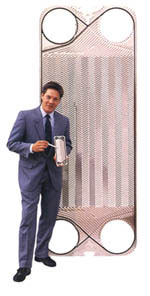 |
||
| Today's process engineering
designers recognize that where working pressures and temperatures are moderate - in the 25 bar and up to 150ºC range - the PHE has no equal in a wide range of industrial applications. Where our PHE is particularly effective is in liquid to liquid heat
transfer where Yet the PHE has also shown itself to be a viable alternative in
applications The extraordinary flexibility of our PHE makes it adaptable to a wide
range of APV offers you the experience gathered in thousands of industrial PHE
installations. APV offers you a lot more than hardware. Advantages of the APV Plate Heat Exchanger in review.
|
|||
|
A pool of fundamental |
|||
| As the originators of the Plate Heat
Exchangers, we have always felt a responsibility to stay at the forefront of its continued development. Our leadership has not come solely out of the laboratory. A long-standing dialogue with customers and consulting organizations - an exchange of information really - makes our products and the recommendations we offer concerning their use acutely sensitive to the real-life requirements of industry. Much of what we have learned is factored into PC design programme. We
are also Our own investigations into various aspects of PHE design have yielded
fundamental Whether you use us as an advisory resource or merely purchase our
hardware, you |
|||
|
...and the service continues |
|||
| Our Service engineers and technicians are
prepared to install or supervise the installation of your PHE and will recommend a maintenance programme. While we can assume complete responsibility for such a programme, your own personnel can undertake most routine maintenance procedures, if you wish. We would of course offer you personnel the necessary instruction. Having dealt with every conceivable type of PHE application, our
experts are well Here are some of the ways in which we can give your PHE a longer productive life: |
|||
| Cleaning on site | Full factory restoration | Inspections | |
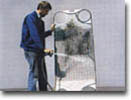 |
 |
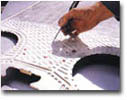 |
|
| Routine on-site cleaning of
your PHE is a simple matter requiring minimal downtime. It can be done in hours or overnight, by APV service personnel or your own staff. |
It involves regasketing, ultrasonic or chemical cleaning of the plates, and an examination for microscopic imperfections that could compromise your process. Damaged plates are replaced. |
In applications using highly corrosive liquids, inspection for hairline crack and other wear can be done on-site by our experienced technicians. They use penetrant dyes and ultraviolet light to get at flaws hidden to the naked eye. |
|
| Regasketing withParaclip gasgets |
Insallation, start-up,training |
Spare parts on call |
|
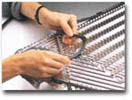 |
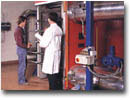 |
 |
|
| While your personnel can
do this with some instruction from us, our experts personnel can also bring the job to a speedy conclusion. Where bonded gaskets are used, regasketing may have to be done in the factory. |
We can
assist or supervise the installation and start-up of new equipment. Routine cleaning tasks can be handled by your own personnel, with a little training, we can provide the necessary instruction. |
PHE spare orders are
rapidly supplied from our computerised stocks in several continents. Where APV PHEs are of vital importance to you production process and interruptions are likely to be very expensive, you should consider having some spare plates or even a spare plate pack in your own stock |
|
|
The APV collection covers |
|||
| Plates are available with effective heat
transfer areas from 0,02m² to 4,75m². The complementary frames are naturally also available. Our largest frame can accommodate 700 plates, providing over 2500m² of surface areas. The plates are available in various gauges stainless steel- a
thoroughly proven molybdenum bearing chrome |
|||
| Avesta 254SLX®* Avesta 254SMO® Hastelloy B-2® Hastelloy C-276® Hastelloy G-3® Incoloy 825® Incoloy 625 ® Nickel Tantalum Titanium Titanium / palladium ® Trademark * Same Composition as udderholm 904L and Sandvik 2RK65 |
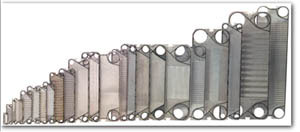 |
||
|
|
|||
| Air-conditioning Plants Condensers Evapoators Heat pump plants |
Chemical Industry Brine Desmophen Different acids Glycerine H2SO4 Isoparaffin Kerosene Process cooling Sour zine |
||
| Automobile Industry Colours in lacquering processes phosphate solutions Quenching oil |
|||
| Extraction Fatty acids Palm oil Raw alcohol Soya bean oil vegetable oil |
Power Generation Closed cooling systems District heating substations Geothermal plants Heat pump plants Heat regeneration plants |
||
| Domestic Plants for heating of floors Preheating of hot water Swimming pools |
Machine Industry Autoclave water Compressor |
||
|
|
|||